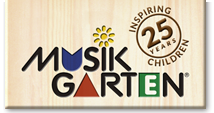Our third and final set of The Neuroscience of Music serieshas begun to explore ways in which early childhood music education can help to develop skills from parents’ Creativity Wish List by teaching children to fall in love with music. This second of four installments in the Creativity Wish List set provides insight and helpful instruction on how to inspire children to compose through music.
“Just think about what it means to compose,” poses Dee Joy Coulter, a nationally recognized Neuroscience educator, “The child must figure out how to begin, how to develop an idea, how to end it well, and finally, how to get others to join in and play it together.”
- Through early childhood group classes, infants, toddlers, and preschoolers experience firsthand how music creates community. Performance of music through familiar songs, stories, and dances create a connection with those participating.
- Music almost always has a set pattern, a composition consisting of a beginning, a repeated musical idea, and a clear ending. Practicing these musical forms develops an understanding of how music is formed and created. Later in life, this understanding of structure will help guide the child in writing papers, working on a project, giving talks, and developing leadership skills.
How music inspires Infants and toddlers to begin to compose
- Family life provides the very earliest forms of composition in how we go about the rhythms and routines of our daily schedule. Coaching these familiar “forms” develop a comfort and bond between family and infant.
- Using traditional songs and music, that have a clear beginning, middle pattern, and end help infants and toddlers to understand the basic structure of music, and when they begin to sing along with or respond to those forms, then they are beginning the earliest stages of composition.
Using music to inspire composition in preschoolers and beginning school age children
- As children grow from toddlerhood to preschool age, their individual aptitude for certain parts of composition start to reveal themselves. Children who show particular delight or enthusiasm about starting something new, may have a propensity for beginnings in composition. Those who love to work on creative tasks over and over until they get it right may work better in the middle parts, while others may love a spectacular ending.
- As parents sing and move with preschool and beginning school children at home or in early childhood group music classes, pointing out the beginning, middle, and end parts of the songs or tunes with them helps to instill a better understanding of music composition.
Dr. Lorna Heyge, founder of Musikgarten reminds us that “Just as with language development skills, in order for children to learn creative thinking skills, they need to be involved in situations where creative thinking is both modeled and nurtured.” Participating in musical activities through repeated and familiar songs and dance provide an opportunity for parents and early childhood music educators to understand the patterns and forms of music composition, while inspiring them to explore and create their own.
*Musikgarten Delivers: The Neuroscience of Music collection by Dr. Dee Coulter is available for $10 in the Product Catalog section of our Teacher Portal. Username and password are required. You may also contact Musikgarten at 800-216-6864 to purchase.





